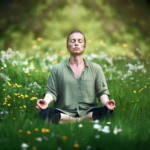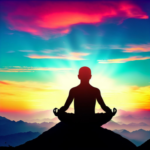If you find yourself constantly battling mental and physical tension, there are effective techniques you can incorporate into your daily routine to help you release and let go.
From mindfulness meditation to deep breathing exercises, each method offers a unique approach to calming your mind and relaxing your body.
These practices not only provide immediate relief but also foster long-term benefits for your overall well-being. By exploring these techniques further, you can discover a path towards a more peaceful and balanced existence.
Mindfulness Meditation
 To release mental and physical tension effectively, consider practicing mindfulness meditation regularly. Mindfulness meditation involves focusing your mind on the present moment, which can help alleviate stress and promote relaxation.
To release mental and physical tension effectively, consider practicing mindfulness meditation regularly. Mindfulness meditation involves focusing your mind on the present moment, which can help alleviate stress and promote relaxation.
Two key techniques within mindfulness meditation that can be particularly helpful are mindful breathing techniques and body scan mindfulness.
Mindful breathing techniques are a fundamental aspect of mindfulness meditation. By directing your attention to your breath, you can anchor yourself in the present moment and cultivate a sense of calm. Begin by finding a comfortable position and taking a few deep breaths. Then, allow your breathing to return to its natural rhythm while maintaining awareness of each inhale and exhale. If your mind wanders, gently bring your focus back to your breath without judgment.
Body scan mindfulness is another valuable practice within mindfulness meditation. This technique involves mentally scanning your body from head to toe, bringing awareness to each part and noticing any sensations without reacting to them. Start by focusing on your toes and work your way up through each body part, releasing any tension you may encounter along the way. Body scan mindfulness can help you identify areas of physical tension and consciously relax those muscles, promoting a deeper sense of relaxation and well-being.
Incorporating mindful breathing techniques and body scan mindfulness into your mindfulness meditation practice can enhance your ability to release mental and physical tension, leading to a greater sense of peace and clarity in your daily life.
Progressive Muscle Relaxation
Consider incorporating progressive muscle relaxation into your routine to effectively release physical tension and promote relaxation. This technique involves tensing specific muscle groups before releasing them, helping to increase awareness of bodily sensations and ultimately reduce overall tension levels.
To get started with progressive muscle relaxation, follow these steps:
-
Begin with a body scan: Take a few deep breaths and focus on each part of your body, starting from your toes and working your way up to your head. This will help you become more attuned to any areas holding tension.
-
Tense and release: Start by tensing a muscle group, such as your fists or shoulders, for about 5-10 seconds, then release the tension completely, allowing the muscles to relax fully.
-
Focus on the sensations: As you release the tension, pay attention to the difference between the feeling of tension and relaxation in the muscle group.
-
Move systematically: Progress through different muscle groups, working from your feet upwards, ensuring each area experiences the tension release process.
-
Practice regularly: Incorporate progressive muscle relaxation into your daily routine to reap the benefits of reduced physical tension and increased relaxation levels.
Deep Breathing Exercises
Explore the benefits of incorporating deep breathing exercises into your routine to enhance relaxation and alleviate mental and physical tension. Deep breathing techniques are powerful tools for calming the mind and relaxing the body. When you feel stressed or overwhelmed, taking a few moments to engage in deep breathing exercises can make a significant difference in your overall well-being.
One effective breathing technique is diaphragmatic breathing, also known as belly breathing. To practice this, sit or lie down in a comfortable position. Place one hand on your chest and the other on your abdomen. Inhale deeply through your nose, allowing your abdomen to rise while keeping your chest relatively still. Exhale slowly through your mouth, feeling your abdomen fall. Repeat this process several times, focusing on the sensation of your breath filling and leaving your body.
Relaxation exercises involving deep breathing can help reduce anxiety, lower blood pressure, and improve sleep quality. These exercises can be done anywhere and at any time, making them convenient for incorporating into your daily routine. By dedicating just a few minutes each day to deep breathing, you can cultivate a sense of calm and relaxation that will benefit both your mental and physical health.
Yoga and Stretching
Incorporating yoga and stretching into your routine can be highly effective in releasing both mental and physical tension. Yoga not only focuses on physical postures but also emphasizes breathing techniques and mindfulness, promoting body awareness and relaxation. Stretching, on the other hand, helps improve flexibility and reduces muscle stiffness, aiding in releasing tension accumulated from daily stressors.
Here’s how yoga and stretching can benefit you:
-
Flowing Movements: Engaging in yoga involves fluid movements that help release tension stored in your muscles and joints, promoting a sense of ease and relaxation throughout your body.
-
Breath Awareness: Yoga places a strong emphasis on connecting movement with breath, fostering a deeper connection to your body and promoting relaxation through mindful breathing techniques.
-
Mindful Stretching: Stretching exercises not only increase flexibility but also help you become more aware of different muscle groups, allowing you to release tension in specific areas of your body.
-
Release of Endorphins: Both yoga and stretching can trigger the release of endorphins, the body’s natural feel-good hormones, reducing stress and promoting a sense of well-being.
-
Improved Posture: Practicing yoga and stretching regularly can help correct posture imbalances, reducing physical tension and promoting overall relaxation and comfort.
Incorporating these practices into your routine can significantly contribute to releasing mental and physical tension, promoting a sense of well-being and relaxation in your daily life.
Journaling for Emotional Release
To further enhance your emotional well-being and release pent-up feelings, consider the therapeutic practice of journaling for emotional release. Journaling is a powerful tool for creative writing and self-reflection. By putting your thoughts and emotions onto paper, you engage in a process of emotional processing that can lead to inner healing.
When you engage in journaling for emotional release, you create a safe space to express yourself freely and without judgment. Through the act of writing, you can explore deeper into your emotions, gaining insights into your innermost thoughts and feelings. This process of self-reflection allows you to investigate the root causes of your emotional tension and begin the healing process.
Writing about your emotions can also help you make sense of complex feelings and experiences. By putting your thoughts into words, you may uncover patterns or connections that were previously unclear to you. This newfound clarity can be empowering and can lead to a greater sense of emotional well-being.
Incorporating journaling into your routine for emotional release can be a cathartic experience. It provides a structured outlet for your feelings, allowing you to release pent-up emotions and make room for healing.
Guided Imagery and Visualization
Consider utilizing guided imagery and visualization techniques to help release mental and physical tension effectively. Creative visualization can be a powerful tool in promoting relaxation responses within your mind and body. Guided meditation is a form of stress relief that allows you to immerse yourself in calming scenarios, aiding in letting go of built-up tension.
Here are some ways you can incorporate guided imagery and visualization into your routine:
-
Imagine yourself in a serene natural setting, surrounded by gentle sounds of nature like rustling leaves or flowing water.
-
Picture a bright, warm light enveloping your body, melting away any stress or tightness you may be feeling.
-
Visualize a peaceful beach scene, feeling the warmth of the sun on your skin and the soft sand beneath your feet, allowing yourself to unwind completely.
-
Envision a tranquil garden filled with beautiful flowers and soothing aromas, breathing in the fragrances deeply to promote a sense of calm.
-
Picture yourself floating on a cloud, weightless and free from any worries or tension, letting go of all negative energy as you drift along effortlessly.
Conclusion
By using these powerful techniques, you can release mental and physical tension like never before. Say goodbye to stress and hello to relaxation!
Embrace mindfulness, deep breathing, yoga, and more to let go of all that built-up tension.
It’s time to take control of your well-being and feel lighter, calmer, and more at peace.
You’ve got this!








